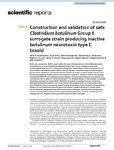2022-02-02Zeitschriftenartikel
Construction and validation of safe Clostridium botulinum Group II surrogate strain producing inactive botulinum neurotoxin type E toxoid
Nowakowska, Maria B.
Selby, Katja
Przykopanski, Adina
Krüger, Maren
Krez, Nadja
Dorner, Brigitte G.
Dorner, Martin B.
Jin, Rongsheng
Minton, Nigel P.
Rummel, Andreas
Lindström, Miia
Botulinum neurotoxins (BoNTs), produced by the spore-forming bacterium Clostridium botulinum, cause botulism, a rare but fatal illness affecting humans and animals. Despite causing a life-threatening disease, BoNT is a multipurpose therapeutic. Nevertheless, as the most potent natural toxin, BoNT is classified as a Select Agent in the US, placing C. botulinum research under stringent governmental regulations. The extreme toxicity of BoNT, its impact on public safety, and its diverse therapeutic applications urge to devise safe solutions to expand C. botulinum research. Accordingly, we exploited CRISPR/Cas9-mediated genome editing to introduce inactivating point mutations into chromosomal bont/e gene of C. botulinum Beluga E. The resulting Beluga Ei strain displays unchanged physiology and produces inactive BoNT (BoNT/Ei) recognized in serological assays, but lacking biological activity detectable ex- and in vivo. Neither native single-chain, nor trypsinized di-chain form of BoNT/Ei show in vivo toxicity, even if isolated from Beluga Ei sub-cultured for 25 generations. Beluga Ei strain constitutes a safe alternative for the BoNT research necessary for public health risk management, the development of food preservation strategies, understanding toxinogenesis, and for structural BoNT studies. The example of Beluga Ei generation serves as template for future development of C. botulinum producing different inactive BoNT serotypes.
Files in this item

